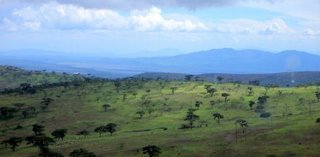
Today I had the delightful opportunity to join another development group in monitoring/evaluating a rain water catchment project. The consultant, Joseph Sang, found my blog on the internet and invited me to join him in the field. He wanted me to compare what Church World Service did with what this project was doing.

I was quite honored to be asked to consult; most of my colleagues could probably have done a better job, but also have work of their own to be doing. I found it quite interesting to compare their project to ours. They had built gutters on tin-roof houses that ran water into a tank, either of concrete and plastic.

Usually, we build larger tanks at schools or other community centers so people come and draw water, hopefully at a shorter distance than wherever they got their previous water source. We also train water management committees to manage the project, overseeing funds and repairs, so that the project is sustainable without our further input. Also, these commmittees allow for the community to save money and decide which project they'd like to tackle next; with their own funds.
This project focused on the individual, but worked through community groups so that those members who didn't receive a tank could use their neighbors until they had a tank of their own. Since there was no charge for the water, however, it seemed that they would have to wait until the next donor came along to get a rain water catchment setup.

There were also questions about which was better: plastic or concrete? Plastic tanks are cheaper and have less maintenance requirements, whereas concrete tanks are bigger and last longer, but cost more and have higher maintenance requirements. For instance, if the tank is too dry for too long, cracks will form and the tank will leak when it's filled again.

All in all, it was an interesting experience to be with another NGO doing similar work. I felt more detached from the project than I normally feel, and sometimes it was hard to keep my focus due to all of the Kiswahili. Nonetheless, I learned more about development from a different perspective and am wondering if this is a field I could pursue. But for now, I'll take these chances as opportunities to expand my knowledge... and contribute just a little where I can.

1 comment:
This is great, you can consult. God bless.
Post a Comment